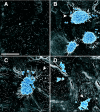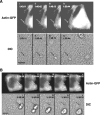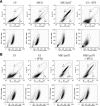Dynamics of Neisseria gonorrhoeae attachment: microcolony development, cortical plaque formation, and cytoprotection
- PMID: 17682045
- PMCID: PMC2044525
- DOI: 10.1128/IAI.00687-07
Dynamics of Neisseria gonorrhoeae attachment: microcolony development, cortical plaque formation, and cytoprotection
Abstract
Neisseria gonorrhoeae is the bacterium that causes gonorrhea, a major sexually transmitted disease and a significant cofactor for human immunodeficiency virus transmission. The retactile N. gonorrhoeae type IV pilus (Tfp) mediates twitching motility and attachment. Using live-cell microscopy, we reveal for the first time the dynamics of twitching motility by N. gonorrhoeae in its natural environment, human epithelial cells. Bacteria aggregate into microcolonies on the cell surface and induce a massive remodeling of the microvillus architecture. Surprisingly, the microcolonies are motile, and they fuse to form progressively larger structures that undergo rapid reorganization, suggesting that bacteria communicate with each other during infection. As reported, actin plaques form beneath microcolonies. Here, we show that cortical plaques comigrate with motile microcolonies. These activities are dependent on pilT, the Tfp retraction locus. Cultures infected with a pilT mutant have significantly higher numbers of apoptotic cells than cultures infected with the wild-type strain. Inducing pilT expression with isopropyl-beta-D-thiogalactopyranoside partially rescues cells from infection-induced apoptosis, demonstrating that Tfp retraction is intrinsically cytoprotective for the host. Tfp-mediated attachment is therefore a continuum of microcolony motility and force stimulation of host cell signaling, leading to a cytoprotective effect.
Figures







Similar articles
-
Attenuation of the Type IV Pilus Retraction Motor Influences Neisseria gonorrhoeae Social and Infection Behavior.mBio. 2016 Dec 6;7(6):e01994-16. doi: 10.1128/mBio.01994-16. mBio. 2016. PMID: 27923924 Free PMC article.
-
Pilus-mediated adhesion of Neisseria meningitidis is negatively controlled by the pilus-retraction machinery.Mol Microbiol. 2006 Jan;59(2):579-89. doi: 10.1111/j.1365-2958.2005.04954.x. Mol Microbiol. 2006. PMID: 16390451
-
PilT is required for PI(3,4,5)P3-mediated crosstalk between Neisseria gonorrhoeae and epithelial cells.Cell Microbiol. 2005 Sep;7(9):1271-84. doi: 10.1111/j.1462-5822.2005.00551.x. Cell Microbiol. 2005. PMID: 16098215
-
Type IV pili and cell motility.Mol Microbiol. 1999 Apr;32(1):1-10. doi: 10.1046/j.1365-2958.1999.01339.x. Mol Microbiol. 1999. PMID: 10216854 Review.
-
Using laser tweezers to measure twitching motility in Neisseria.Curr Opin Microbiol. 2005 Jun;8(3):344-9. doi: 10.1016/j.mib.2005.04.002. Curr Opin Microbiol. 2005. PMID: 15939360 Review.
Cited by
-
Construction and characterization of a derivative of Neisseria gonorrhoeae strain MS11 devoid of all opa genes.J Bacteriol. 2012 Dec;194(23):6468-78. doi: 10.1128/JB.00969-12. Epub 2012 Sep 21. J Bacteriol. 2012. PMID: 23002223 Free PMC article.
-
Seminal Plasma Promotes Neisseria gonorrhoeae Aggregation and Biofilm Formation.J Bacteriol. 2016 Jul 28;198(16):2228-35. doi: 10.1128/JB.00165-16. Print 2016 Aug 15. J Bacteriol. 2016. PMID: 27274027 Free PMC article.
-
Expression of Opacity Proteins Interferes with the Transmigration of Neisseria gonorrhoeae across Polarized Epithelial Cells.PLoS One. 2015 Aug 5;10(8):e0134342. doi: 10.1371/journal.pone.0134342. eCollection 2015. PLoS One. 2015. PMID: 26244560 Free PMC article.
-
Crash landing of Vibrio cholerae by MSHA pili-assisted braking and anchoring in a viscoelastic environment.Elife. 2021 Jul 2;10:e60655. doi: 10.7554/eLife.60655. Elife. 2021. PMID: 34212857 Free PMC article.
-
Upregulation of ATF3 inhibits expression of the pro-inflammatory cytokine IL-6 during Neisseria gonorrhoeae infection.Cell Microbiol. 2013 Nov;15(11):1837-50. doi: 10.1111/cmi.12153. Epub 2013 May 23. Cell Microbiol. 2013. PMID: 23648135 Free PMC article.
References
-
- Achtman, M., M. Neibert, B. A. Crowe, W. Strittmatter, B. Kusecek, E. Weyse, M. J. Walsh, B. Slawig, G. Morelli, A. Moll, et al. 1988. Purification and characterization of eight class 5 outer membrane protein variants from a clone of Neisseria meningitidis serogroup A. J. Exp. Med. 168:507-525. - PMC - PubMed
-
- Ayala, P., J. S. Wilbur, L. M. Wetzler, J. A. Tainer, A. Snyder, and M. So. 2005. The pilus and porin of Neisseria gonorrhoeae cooperatively induce Ca2+ transients in infected epithelial cells. Cell. Microbiol. 7:1736-1748. - PubMed
-
- Belmokhtar, C. A., J. Hillion, and E. Segal-Bendirdjian. 2001. Staurosporine induces apoptosis through both caspase-dependent and caspase-independent mechanisms. Oncogene 20:3354-3362. - PubMed
-
- Bernard, B., T. Fest, J. L. Pretet, and C. Mougin. 2001. Staurosporine-induced apoptosis of HPV positive and negative human cervical cancer cells from different points in the cell cycle. Cell Death. Differ. 8:234-244. - PubMed
Publication types
MeSH terms
Substances
Grants and funding
LinkOut - more resources
Full Text Sources
Other Literature Sources
Research Materials

